Tomb Murals with Largest Known Hunting Scene of the Northern Dynasties Discovered in Shanxi, NW China
From:Chinese Archaeology NetWriter:Date:2015-01-23
From September 2013 until 2014, an archaeological team formed by an alliance between Shanxi Institute of Archaeology and the Xinzhou Bureau of Cultural Relics excavated the Jiuyuangang tomb in Xinzhou city, Shanxi province, to rescue and protect the tomb murals. The surrounding walls of the above-mentioned tomb were also sought to confirm the approximate range of the cemetery.The tomb had an inclined passage leading to a single chamber constructed of brick that faced south. The total length of the tomb including all four parts—earth mound, tomb passage, vaulted passage, and burial chamber—was more than 50 meters long. The existing mound was an irregular circle measuring approximately 16-26 meters in diameter and 4 meters high. The mound was constructed of rammed pale yellow earth, with the bottom half of relatively good, solid quality, while the upper part was of relatively poor quality. Of the original stone door located at the southern end of the vaulted passage, only the stone lintel remained. A burial chamber within the square earthen pit measured 5.9 meters east to west, 5.75 meters north to south, and approximately 8.8 meters high with dome ceiling. Four walls had had murals originally, but they were almost completely destroyed. Only an astrological chart on the topmost part remained.
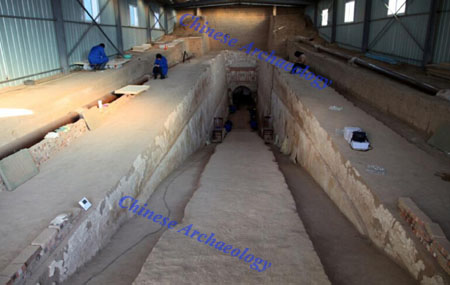
an inclined passage leading to a single chamber constructed of brick that faced south
This excavation exposed more than 240 square meters of murals and also unearthed a large amount of pottery figurines, iron coffin nails, pottery and porcelain fragments, etc. The murals covered three walls (northern, eastern, and western) of the tomb passage as well as the walls of the chamber itself. The murals in the tomb passage were divided into four zones from top to bottom, with relatively identical content on both left and right sides. The first zone depicts strange and unusual birds and animals amid flowing clouds, along with Daoist immortals Lei Gong, Lord of Thunder, and Feng Bo, Earl of Wind, accompanied by dragons and cranes. These mythological entities have characteristic of both the Han Dynasty (206 BC-220 AD) and the Northern Dynasty (386-581).
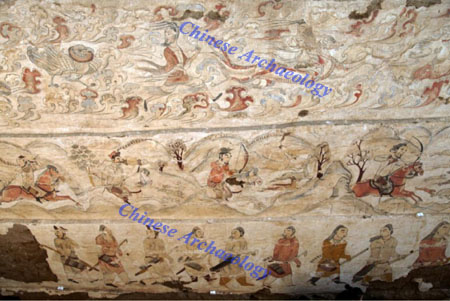
part of the mural at the east wall of the tomb passage
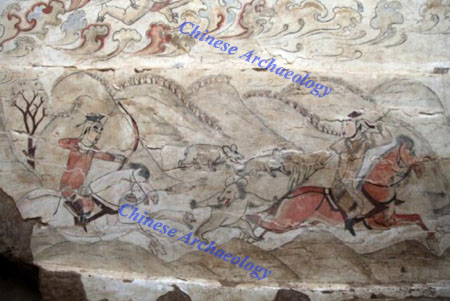
part of the mural at the east wall of the tomb passage
The second mural zone is the largest picture to depict hunting discovered in China to-date. It is nearly 30 meters long and 1.6 meters high, and it covers both sides of the tomb passage. It depicts numerous hunters on horseback, galloping through forest and mountains, using falcons and dogs to chase tiger, bear, deer, and wild goats. It appears to be a historical scene of ethnic soldiers training to hunt. The third and fourth mural zones depict the long journey of ordinary soldiers: tall, dressed in tiger and leopard skins, wearing a sword on the belt and carrying a bow. They appear to be of a different ethnicity. The depiction is the epitome of bold and powerful Northern Dynasties troops converging in battle. The mural on the northern wall of the tomb passage (i.e., above the vaulted passage) appearing wooden buildings was discovered first in the contemporary tomb and showed architectural details of a Northern Dynasties style.
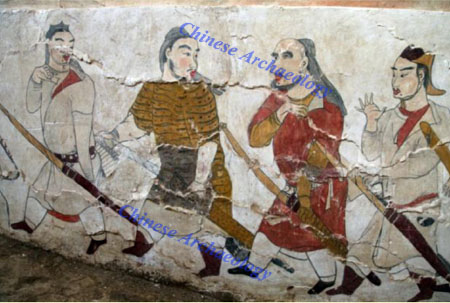
part of the mural at the west wall of the tomb passage
The mural in the burial chamber itself had three zones: (from top to bottom) an astrological (star) chart, a depiction of four deities, and the oxcart and saddled horse. Because the tomb epigraph was missing, the identity of the individual interred in the tomb is unknown at this time. Based on the characters/figures in the murals and a preliminary assessment of the grave goods found in the tomb, the age of the tomb is dated from the Eastern Wei period (534-550) to the early Qi period (550-557) of the Northern Dynasties. Considering both the scale and prominent elegance of the tomb, it is speculated that the tomb’s occupant was an important member of Gao royal family.
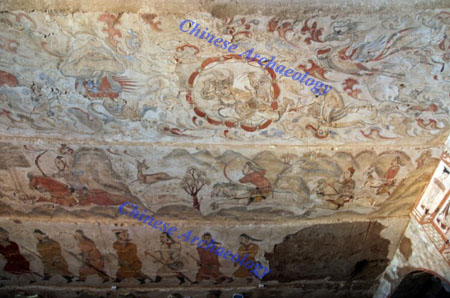
part of the mural at the west wall of the tomb passage
This new archaeological discovery has several important aspects.
First, the rich content of these tomb murals during the Eastern Wei (534-550) and early Qi (550-557) eras provides a valuable insight into social, cultural, and military life of the Northern Dynasties.
Second, the complex depiction of the afterlife appears to be a complete system in itself, showing the Northern Dynasties cultural concepts of life, death, and the spirit world.
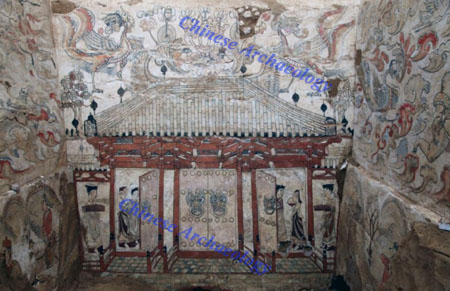
part of the mural at the topmost of north wall (on the top of the door) of the tomb passage
Third, not only is the mural depicting the hunting scene the largest historical hunting scene found in China to-date, it appears to portray the actual army training to hunt methods found in the historical book Army Training to Hunt Manual. Therefore the mural is an important and valuable source of information for research on Northern Dynasties army training and way of life.
Fourth, in the mural depicting the soldiers on a long journey, their apparel reflects a preference, or cultural custom, for wearing animal skins, suggesting a rugged individuality. That style of dress is very different from the clean-cut apparel of ethnic Wei officers and soldiers, based on previously excavated burial pottery figurines and murals depicting ethnic Wei.
Fifth, the mural of wooden building on the northern wall of the tomb passage is the first time discovery, and an entire Northern Dynasties wooden construction has been reconstructed. This is a good source of information for research on wooden constructions of the period.
The Northern Dynasties cities of Yecheng, Changan, Jinyang, etc. were big cultural and political centers. The discovery Xinzhou mural tomb helps both to confirm that chamber murals in different regions have different origins and characteristics and to expand any previous understanding of the ethnic group’s range of cultural influence in Jinyang area. (Translator: Grace Warren)

